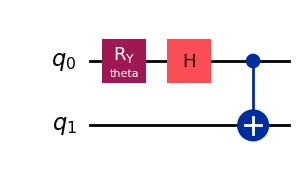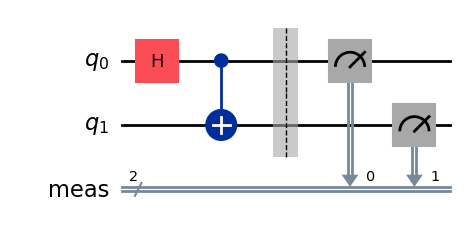Exact simulation with Qiskit SDK primitives
The reference primitives in the Qiskit SDK perform local statevector simulations. These simulations do not support modeling device noise, but are useful for quickly prototyping algorithms before looking into more advanced simulation techniques (using Qiskit Aer) or running on real devices (Qiskit Runtime primitives).
The Estimator primitive can compute expectation values of circuits, and the Sampler primitive can sample
from output distributions of circuits.
The following sections show how to use the reference primitives to run your workflow locally.
Use the reference Estimator
There are two reference implementations of Estimator in qiskit.primitives that run on a local statevector
simulators: the StatevectorEstimator class and the
Estimator class. The StatevectorEstimator
implements the new Estimator V2 interface introduced in the Qiskit SDK 1.0, and offers additional input vectorization
features in comparison with the Estimator class, which implements the
legacy Estimator V1 interface. (For more information, see the V2 primitives migration guide.) Both can take circuits, observables, and parameters as inputs and return the locally
computed expectation values.
The following code prepares the inputs that will be used in the examples that follow. The expected input type for the
observables is qiskit.quantum_info.SparsePauliOp. Note that
the circuit in the example is parametrized, but you can also run the Estimator on non-parametrized circuits.
Any circuit passed to an Estimator must not include any measurements.
from qiskit import QuantumCircuit
from qiskit.circuit import Parameter
# circuit for which you want to obtain the expected value
qc = QuantumCircuit(2)
qc.ry(Parameter('theta'), 0)
qc.h(0)
qc.cx(0,1)
qc.draw("mpl", style="iqp")
from qiskit.quantum_info import SparsePauliOp
import numpy as np
# observable(s) whose expected values you want to compute
from qiskit.quantum_info import SparsePauliOp
observable = SparsePauliOp(["II", "XX", "YY", "ZZ"], coeffs=[1, 1, -1, 1])
# value(s) for the circuit parameter(s)
parameter_values = [[0], [np.pi/6], [np.pi/2]]The Qiskit Runtime primitives workflow requires circuits and observables to be transformed to only use instructions supported by the QPU (referred to as instruction set architecture (ISA) circuits and observables). The reference primitives still accept abstract instructions, as they rely on local statevector simulations, but transpiling the circuit might still be beneficial in terms of circuit optimization.
# Generate a pass manager without providing a backend
from qiskit.transpiler.preset_passmanagers import generate_preset_pass_manager
pm = generate_preset_pass_manager(optimization_level=1)
isa_circuit = pm.run(qc)
isa_observable = observable.apply_layout(isa_circuit.layout)Initialize Estimator
To use the Estimator V2 implementation, follow the instructions to instantiate a
qiskit.primitives.StatevectorEstimator. If you want to maintain
your pre-existing workflow using an Estimator V1 implementation, you can also use the
qiskit.primitives.Estimator class.
Instantiate a qiskit.primitives.StatevectorEstimator.
from qiskit.primitives import StatevectorEstimator
estimator = StatevectorEstimator()Instantiate a qiskit.primitives.Estimator.
from qiskit.primitives import Estimator
estimator = Estimator()Run and get results
This example only uses one circuit (of type QuantumCircuit) and one
observable.
Run the estimation by calling the StatevectorEstimator.run
method, which returns an instance of a PrimitiveJob object. You can get the results from the
job (as a qiskit.primitives.PrimitiveResult object)
with the qiskit.primitives.PrimitiveJob.result method.
job = estimator.run([(isa_circuit, isa_observable, parameter_values)])
result = job.result()
print(f" > Result class: {type(result)}") > Result class: <class 'qiskit.primitives.containers.primitive_result.PrimitiveResult'>Run the estimation by calling the Estimator.run method,
which returns an instance of qiskit.providers.JobV1. You can get the results from the
job (as an EstimatorResult object)
with the JobV1.result method.
pm = generate_preset_pass_manager(backend=backend, optimization_level=1)
isa_circuit = pm.run(qc)
job = estimator.run([isa_circuit]*3, [isa_observable]*3, parameter_values)
result = job.result()
print(f" > Result class: {type(result)}") > Result class: <class 'qiskit.primitives.base.estimator_result.EstimatorResult'>Get the expected value from the result
The primitives V2 result outputs an array of PubResults, where each item of the array is a PubResult object
that contains in its data the array of evaluations corresponding to every circuit-observable combination in the PUB.
To retrieve the expectation values and metadata for the first
(and in this case, only) circuit evaluation, we must access the evaluation data for PUB 0:
print(f" > Expectation value: {result[0].data.evs}")
print(f" > Metadata: {result[0].metadata}") > Expectation value: [4. 3.73205081 2. ]
> Metadata: {'precision': 0.0}The primitives V1 result stores an array of values that can be accessed through the attribute
EstimatorResult.values, where theith
element is the expectation value corresponding to the ith circuit and ith observable.
To see the values for the first (and in this case, only) circuit evaluation, we must access the first item of the array.
print(f" > Expectation value: {result.values[0]}")
print(f" > Metadata: {result.metadata}") > Expectation value: 3.999999999999999
> Metadata: [{}, {}, {}]Set Estimator run options
By default, the reference Estimator performs an exact statevector calculation based on the
quantum_info.Statevector class.
However, this can be modified to introduce the effect of the sampling overhead (also known as "shot noise").
With the introduction of the new V2 interface, the sampling overhead in the Estimator is now more concretely defined.
The new interface accepts a precision argument that expresses the error bars that the
primitive implementation should target for expectation values estimates,
instead of the number of shots used in the V1 interface.
The sampling overhead is now called precision, and is defined exclusively at the .run()
method level. This allows for a more finely-grained tuning of the option all the way to the PUB level.
This example assumes you have defined two circuits, each with its own array of observables.
# Estimate expectation values for two PUBs, both with 0.05 precision.
estimator.run([(isa_circuit1, isa_obs_array1), (isa_circuit2, isa_obs_array_2)], precision=0.05)The V1 interface specifies shots in the following ways:
- Setting keyword arguments in the
qiskit.primitives.Estimator.runmethod. - Modifying the
qiskit.primitives.Estimatoroptions.
job = estimator.run(isa_circuit, isa_observable, shots=2048, seed=123)
result = job.result()For a full example, see the Primitives examples page.
Use the reference Sampler
Similar to the Estimator, there are two reference implementations of Sampler in qiskit.primitives:
the StatevectorSampler class and the
Sampler class. The StatevectorSampler
implements the new Estimator V2 interface introduced in Qiskit 1.0, and offers additional input vectorization
features in comparison with the Sampler class, which implements the
legacy Sampler V1 interface. (For more information, see the V2 primitives migration guide.) Both can take circuits and parameters as inputs and return the results from sampling from
the output probability distributions, but they are expressed in different terms:
- The new StatevectorSampler (V2) output can be expressed as an array of sampled values (bitstring) or "counts" for each bitstring present in the output distribution.
- The Sampler (V1) output is always expressed as a quasi-probability distribution of output states.
The following code prepares the inputs used in the examples that follow. Note that these examples run a single parametrized circuit, but you can also run the Sampler on non-parametrized circuits.
from qiskit import QuantumCircuit
qc = QuantumCircuit(2)
qc.h(0)
qc.cx(0,1)
qc.measure_all()
qc.draw("mpl", style="iqp")
Any quantum circuit passed to a Sampler must include measurements.
The Qiskit Runtime primitives workflow requires circuits to be transformed to only use instructions supported by the QPU (referred to as instruction set architecture (ISA) circuits). The reference primitives still accept abstract instructions, as they rely on local statevector simulations, but transpiling the circuit might still be beneficial in terms of circuit optimization.
# Generate a pass manager without providing a backend
from qiskit.transpiler.preset_passmanagers import generate_preset_pass_manager
pm = generate_preset_pass_manager(optimization_level=1)
isa_circuit = pm.run(qc)
isa_observable = observable.apply_layout(isa_circuit.layout)Initialize Sampler
To use the Sampler V2 implementation, follow the instructions to instantiate a
qiskit.primitives.StatevectorSampler. If you want to maintain
your pre-existing workflow using a Sampler V1 implementation, you can also use the
qiskit.primitives.Sampler class.
from qiskit.primitives import StatevectorSampler
sampler = StatevectorSampler()from qiskit.primitives import Sampler
sampler = Sampler()Run and get results
# execute 1 circuit with Sampler V2
job = sampler.run([isa_circuit])
pub_result = job.result()[0]
print(f" > Result class: {type(pub_result)}")> Result class: <class 'qiskit.primitives.containers.pub_result.PubResult'>V2 primitives accept multiple PUBs as inputs, and each PUB gets its own result. Therefore, you can run different circuits with various parameter/observable combinations, and retrieve the PUB results:
from qiskit.transpiler.preset_passmanagers import generate_preset_pass_manager
# create two circuits
circuit1 = qc.copy()
circuit2 = qc.copy()
# transpile circuits
pm = generate_preset_pass_manager(optimization_level=1)
isa_circuit1 = pm.run(circuit1)
isa_circuit2 = pm.run(circuit2)
# execute 2 circuits using Sampler V2
job = sampler.run([(isa_circuit1), (isa_circuit2)])
pub_result_1 = job.result()[0]
pub_result_2 = job.result()[1]
print(f" > Result class: {type(pub_result)}")> Result class: <class 'qiskit.primitives.containers.pub_result.PubResult'>Run Sampler by calling the qiskit.primitives.Sampler.run
method, which returns an instance of qiskit.providers.JobV1.
You can get the results from the job (as a qiskit.primitives.SamplerResult object)
with the qiskit.providers.JobV1.result method.
job = sampler.run(isa_circuit)
result = job.result()
print(result)SamplerResult(quasi_dists=[{0: 0.4999999999999999, 3: 0.4999999999999999}], metadata=[{}])Get the probability distribution or measurement outcome
As mentioned above, the result retrieval step is different between V1 and V2 interfaces.
The V1 sampler gives access to quasi-probability distributions.
The V2 sampler returns measurement outcome samples in the form of bitstrings or counts. The bitstrings show the measurement outcomes, preserving the shot order in which they were measured. The V2 sampler result objects organize data in terms of their input circuits' classical register names, for compatibility with dynamic circuits.
"meas".
This name will be used later to access the measurement bitstrings.# Define quantum circuit with 2 qubits
circuit = QuantumCircuit(2)
circuit.h(0)
circuit.cx(0, 1)
circuit.measure_all()
circuit.draw() ┌───┐ ░ ┌─┐
q_0: ┤ H ├──■───░─┤M├───
└───┘┌─┴─┐ ░ └╥┘┌─┐
q_1: ─────┤ X ├─░──╫─┤M├
└───┘ ░ ║ └╥┘
meas: 2/══════════════╩══╩═
0 1 # Transpile circuit
pm = generate_preset_pass_manager(optimization_level=1)
isa_circuit = pm.run(circuit)
# Run using V2 sampler
result = sampler.run([circuit]).result()
# Access result data for PUB 0
data_pub = result[0].data
# Access bitstring for the classical register "meas"
bitstrings = data_pub.meas.get_bitstrings()
print(f"The number of bitstrings is: {len(bitstrings)}")
# Get counts for the classical register "meas"
counts = data_pub.meas.get_counts()
print(f"The counts are: {counts}")The number of bitstrings is: 1024
The counts are: {'11': 503, '00': 521}A quasi-probability distribution differs from a probability distribution in that negative values are also allowed. However, the quasi-probabilities must sum up to 1 like probabilities. Negative quasi-probabilities may appear when using error mitigation techniques.
# Define quantum circuit with 2 qubits
circuit = QuantumCircuit(2)
circuit.h(0)
circuit.cx(0, 1)
circuit.measure_all()
circuit.draw() ┌───┐ ░ ┌─┐
q_0: ┤ H ├──■───░─┤M├───
└───┘┌─┴─┐ ░ └╥┘┌─┐
q_1: ─────┤ X ├─░──╫─┤M├
└───┘ ░ ║ └╥┘
meas: 2/══════════════╩══╩═
0 1 # Transpile circuit
pm = generate_preset_pass_manager(optimization_level=1)
isa_circuit = pm.run(circuit)
# Run using V1 sampler
result = sampler_v1.run(isa_circuit).result()
quasi_dist = result.quasi_dists[0]
print(f"The quasi-probability distribution is: {quasi_dist}")The quasi-probability distribution is: {0: 0.5, 3: 0.5}If you prefer to see the output keys as binary strings instead of decimal numbers, you can use the qiskit.result.QuasiDistribution.binary_probabilities method.
print(quasi_dist.binary_probabilities()){'00': 0.4999999999999999, '11': 0.4999999999999999}Change run options
By default, the reference Sampler performs an exact statevector calculation based on the
quantum_info.Statevector class.
However, this can be modified to introduce the effect of the sampling overhead (also known as "shot noise").
With the introduction of the new V2 interface, the sampling overhead in the Sampler is now more precisely defined.
The new interface accepts a shots argument that can be defined at the "PUB level".
This example assumes you have defined two circuits.
# Sample two circuits at 128 shots each.
sampler.run([isa_circuit1, isa_circuit2], shots=128)
# Sample two circuits at different amounts of shots. The "None"s are necessary
# as placeholders
# for the lack of parameter values in this example.
sampler.run([(isa_circuit1, None, 123), (isa_circuit2, None, 456)])The V1 interface specifies shots in the following ways:
- Setting keyword arguments in the
Sampler.runmethod. - Modifying the
Sampleroptions.
job = sampler.run(isa_circuit, shots=2048, seed=123)
result = job.result()
print(result)SamplerResult(quasi_dists=[{0: 0.5205078125, 3: 0.4794921875}], metadata=[{'shots': 2048}])For a full example, see the Primitives examples page.
Next steps
- For higher-performance simulation that can handle larger circuits, or to incorporate noise models into your simulation, see Exact and noisy simulation with Qiskit Aer primitives.
- To learn how to use Quantum Composer for simulation, try the Explore gates and circuits with the Quantum Composer(opens in a new tab) tutorial.
- Read the Qiskit Estimator API reference.
- Read the Qiskit Sampler API reference.
- Learn how to run on a QPU in the Run step of the Qiskit patterns workflow.